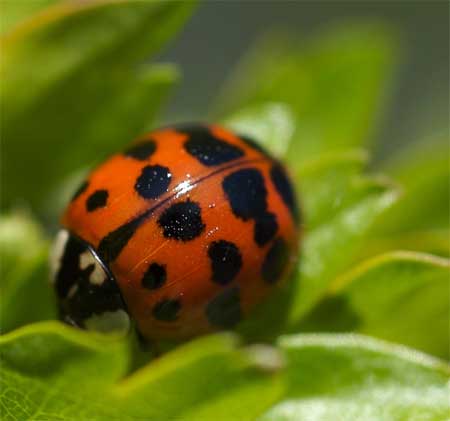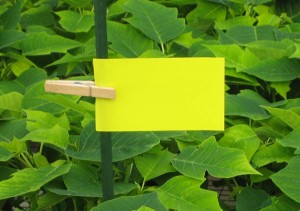Aquaponics and Insect Control
Running a successful Aquaponics system means being pesticide free because any poisons you spray will risk killing all your fish especially if the poisons drift onto the surface of the fish water.
Whether you like it or not you will need to run your aquaponics system as a clean natural Eco-system. Which is good for your health and your bottom line especially as more consumers becoming aware of the quality of the food they want eat. This is fine in a small backyard aquaponics system with a mix of different crops, problems with insects are usually kept to a minimum. Using garlic and pepper sprays may offer slight relief but what about the larger commercial farm operation?
How do commercial operators keep their crops from being destroyed by various plagues of insects without resorting to spraying poisons?
Beneficial Insect Control
With aquaponics one should look to see how hydroponic growers are managing their crops using beneficial bugs or predator insects that naturally prey on invasive bugs to keep the ecological balance in place.
One of the largest hydroponic growers in the US is Eurofresh Farms in Willcox, Arizona. They have stopped using expensive pesticides and have instituted a program of beneficial insect control. A system of yellow sticky cards are placed throughout their greenhouses. One card is placed per 1,000 square foot of growing space. They’re used to help monitor insect populations, as well as to collect insects for identification. Yellow is a colour that attracts certain insects. Permaculture Gardens normally feature yellow marigolds scattered amongst their garden-beds, to distract pests. Even football teams in yellow shirts have difficulty escaping bugs when they’re out in season. Yellow cars also tend to have a reputation for attracting a greater number of bugs!
In hydroponic greenhouses bug inspectors periodically monitor the sticky yellow cards to identify the bug species before an infestation breaks out.
Releasing predator bugs that naturally eat certain insects keeps the system in balance and surprisingly is a cheaper and more cost effective solution than spraying with pesticides.
So what are some of the common pests you may find in your aquaponics system and what predator bugs can use to control them?
Timelapse of aphid infestation
Common Predators and their uses
Ladybeetles
Hippodamia convergens
Lady-beetles or Ladybugs zero in on aphids before they can do much damage. Each beetle can knock off around 5,000 aphids over the course of a year! Lady-beetles feed on aphids, mites, scales, thrips and whiteflies. They can also supplement their diet by feeding on pollen, nectar and honeydew. You can encourage ladybeetles to your system by growing any of the following plants such as dill, cilantro, yarrow, wild carrot, angelica, white cosmos, geraniums and dandelions. You can also buy ladybugs online. They are usually priced around $17 to $20 per shipment. You will receive a bag with around 1,500 bugs that will service a 1,000 square foot greenhouse.
Ladybug predators
Parasitic Wasp
Aphidius colemani
This small black wasp (2-3 mm.) with narrow waist and long antennae has a nasty habit of laying its eggs directly into the body of an aphid! The aphid body bloats and mummifies. The wasp larvae cuts an exit hole out of the dead aphid to mate and resume the cycle. A nasty way to die for the aphid. Optimum conditions for these insects are 18-26C (65-80F).
Note: Check out this National Geographic Video of the black parasitic wasp impregnating aphids.
NOTE: Gruesome footage of the Parasitic wasp larvae exploding out of a caterpillar.
How did they get the camera inside the bug?!
Praying Mantis
Tender aridifolia sinensis
A general purpose predator the Praying Mantis feeds on aphids, beetles, caterpillars, chinch bugs, colorado potato beetles, leafhoppers, horn worms, leaf rollers, squash bugs, thrips and whiteflies.
Lacewings
Chrysoperla carnea,
Lacewings make a good all-around predator, as they attack aphids, mealybugs, whitefly, and thrips. Their aphid kill rate is reported around 100 per week and generally work at night. To service a 1,000 square foot greenhouse you would require around 2,000 lacewings for an investment around $70 from various biological insect supply vendors. You can also try and attract lacewings to your garden by growing certain kinds of flowers in or near your aquaponics system. They are said to be attracted to sunflowers, cosmos and even dandelions.
Adult lacewings are green or brown in colour and the larvae are brown. . Optimum Conditions 24-28C (75-80F).
Spider Mite Predators
Phytoseiulus persimilis
Spider mites attack over 200 different vegetables and fruit trees, sucking the sap and weakening the plant. Predator mites like to kill spider mites. These bright orange predator mites have a short lifespan of around 45 days but knock off and kill between 5 and 20 spider mites each day. Optimum Conditions, 22-35C (72-100F), 60-80% humidity.
Aphid Predator Midge
Aphidoletes aphidimyza
Adults are tiny fly-like midges that resemble small mosquitos are only active at night. The midges search out Aphid colonies by scent and once a colony has been located they lay their eggs beside it. The Larva hatch in 2 – 3 days and will kill more aphids than they can consume. Some studies recommend a ratio of 1 predator midge larvae per 15 aphids for optimal control. Larvae are slender orange shaped and about 2 mm. Midge larvae like humid conditions 21-28C (68-81F).
Beneficial Nematodes
Steinernema feltia
Beneficial Nematodes are microscopic natural parasites that feed on bacteria and can infect insect parasites that visit your system. We all know an aquaponic system functions with good bacteria so nematodes must also be part of the equation. Beneficial nematodes kill more than 250 different pest larvae. 90% of all insects spend at least part of their life cycle in the soil. Its unclear how many insects spend any time laying eggs in your aquaponics grow-bed which is free of the soil and media based. Beneficial Nematodes are usually mixed with water and applied to the infested area where it will infest and kill its prey within 48 hours.
Prevention
Most healthy well managed Aquaponics system require none of these predator pests as the natural balance is constantly maintained. A good mix of plant species will confuse and minimize insect damage. Planting yellow marigolds and strong scented plants can also confuse pests. By constant vigilance and monitoring crops for damage and becoming familiar with pests and their natural predators you can take action to minimize problems before they escalate.









Recent Comments